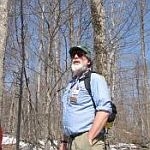 (Host) The snow is melting, but in parts of southern Vermont, the winter leaves a more enduring legacy — a landscape altered by an early winter ice storm that ravaged acres of woods and cherished yard trees.
(Host) The snow is melting, but in parts of southern Vermont, the winter leaves a more enduring legacy — a landscape altered by an early winter ice storm that ravaged acres of woods and cherished yard trees.
On Saturday, dozens of residents from Windham County – the hardest hit region in this state — turned out for a workshop with forest experts on what to do about the damage.
VPR’s Susan Keese reports.
(Keese) It started as a snowstorm. But on the night of December 11, in parts of New England, a wedge of warm air melted the snow as it fell. Then it froze back up again as it hit cold surfaces near the ground, depositing a thick coat of ice.
(Van Loon) "And so when we woke up on Friday morning it was just a constant sound of trees breaking and falling down. It completely changed the way it looks around our house…"
(Keese) Pieter van Loon is a forester who lives in Marlboro, where some of the worst damage occurred. He helped organize the workshop.
(Keese) Windham County Forester Bill Guenther had safety on his mind first and foremost, as he led a group into a wood lot where splintered treetops and limbs dangled precariously overhead .
(Guenther ) "There’s a lot of overhead hazards, a lot of large branches and limbs and what we call widowmakers that could cause a lot of damage to folks so we want to be very careful…"
(Keese) The foresters said many trees with serious crown loss will eventually rebound, and the wind will bring the loose branches down. In the meantime, some advised wearing a hard hat in damaged woods on windy days, and marking off areas where children shouldn’t play.
Guenther found another hazard in a tangle of fallen trees and bent saplings just emerging from the snow .
(Guenther) "If you are going to tackle some of this stuff, don’t just fire up the saw and start making fast cuts .I’d probably spend a good 15-20 minutes just walking around this eyeballing what’s lying on what. If you just cut the top of it, that snaps back, that can cause a fatal injury."
(Keese) Dealing with hazards closer to the house should be the first priority, the forest experts said.
Yard trees that pose a danger and can’t be saved should be removed quickly. In most cases that means trees with cracked or damaged trunks or obvious root damage.
(Hand saw sound)
Trees with broken branches will often come back if the tree is otherwise healthy and the break hasn’t damaged the tree’s core. State tree specialist Rick White recommended pruning ragged breaks to avoid further damage.
(White) "So we make the cut, you know underneath (saw sfx) and then we make the final cut up here like this…."
(Keese) He also urged homeowners to get professional help on any tree that can’t be reached without a ladder.
The experts said the lessons of the northern Vermont ice storm of 1998 have guided them in this recovery. And one of those lessons is that trees are more resilient than anyone suspected.
It’ll take time they say, but the damaged landscape will bounce back.
For VPR News, I’m Susan Keese.
(Host) For more information on dealing with ice damage contact your county forester or the Vermont Department of Forests and Parks.